Strategic Position and Choice: US Airline Industry Analysis Report
VerifiedAdded on 2023/01/18
|16
|3938
|91
Report
AI Summary
This report provides a comprehensive strategic analysis of the US airline industry. It begins with an executive summary and introduction, followed by a historical overview of economic performance and an examination of the external environment, including PESTLE analysis. The report then delves into Porter's Five Forces to assess industry attractiveness, analyzing competition, threat of entry, rivalry, and bargaining power of buyers and suppliers. A discussion section examines key drivers like fuel costs, revenues, demand, and capacity. The report concludes with recommendations for strategic choices airlines should adopt to improve profitability, referencing relevant academic sources. The analysis focuses on the challenges and opportunities within the industry, including the impact of deregulation, low-cost carriers, and external factors such as political and economic conditions. The report aims to provide a thorough understanding of the industry's competitive landscape and strategic considerations for sustained success.
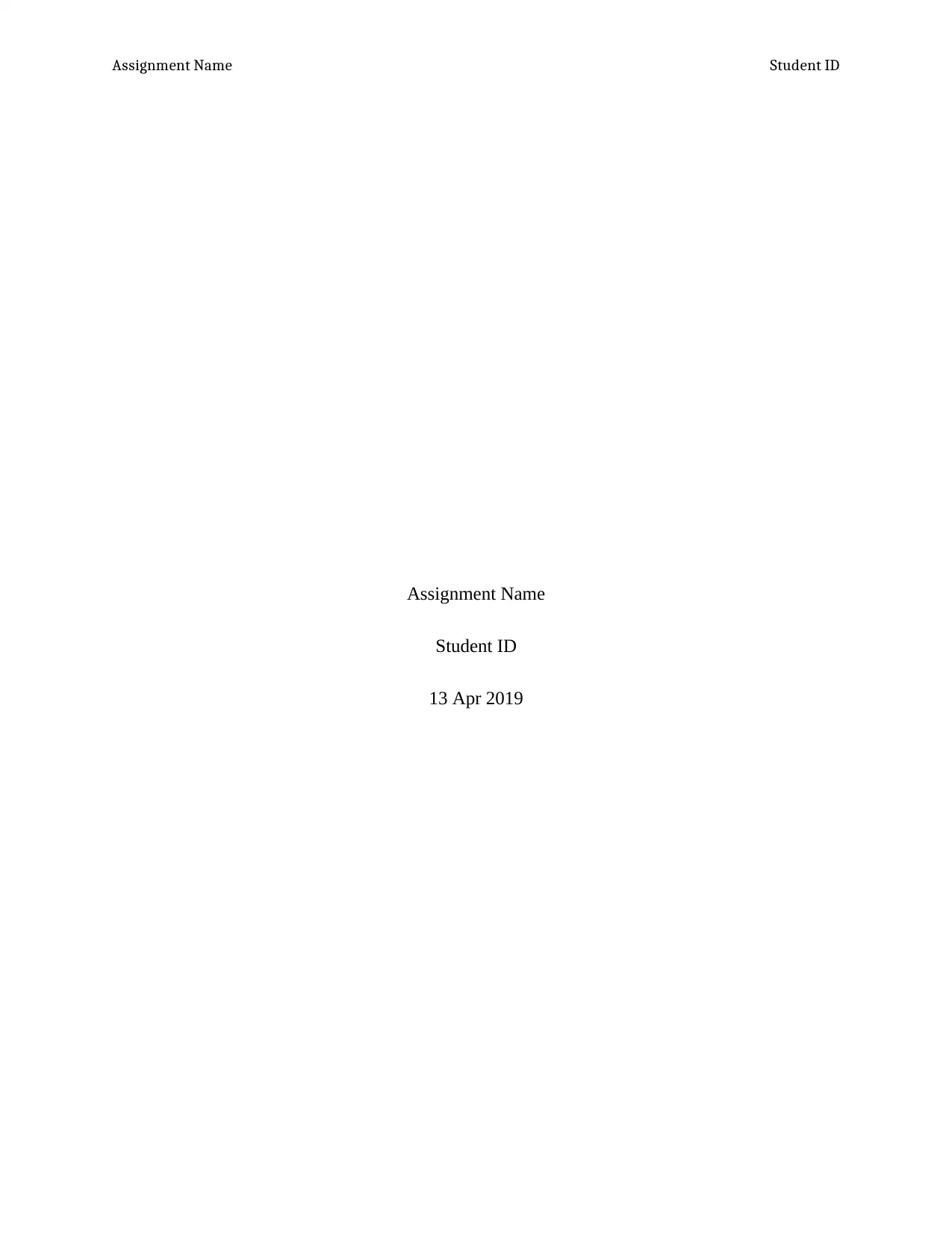
Assignment Name Student ID
Assignment Name
Student ID
13 Apr 2019
Assignment Name
Student ID
13 Apr 2019
Paraphrase This Document
Need a fresh take? Get an instant paraphrase of this document with our AI Paraphraser
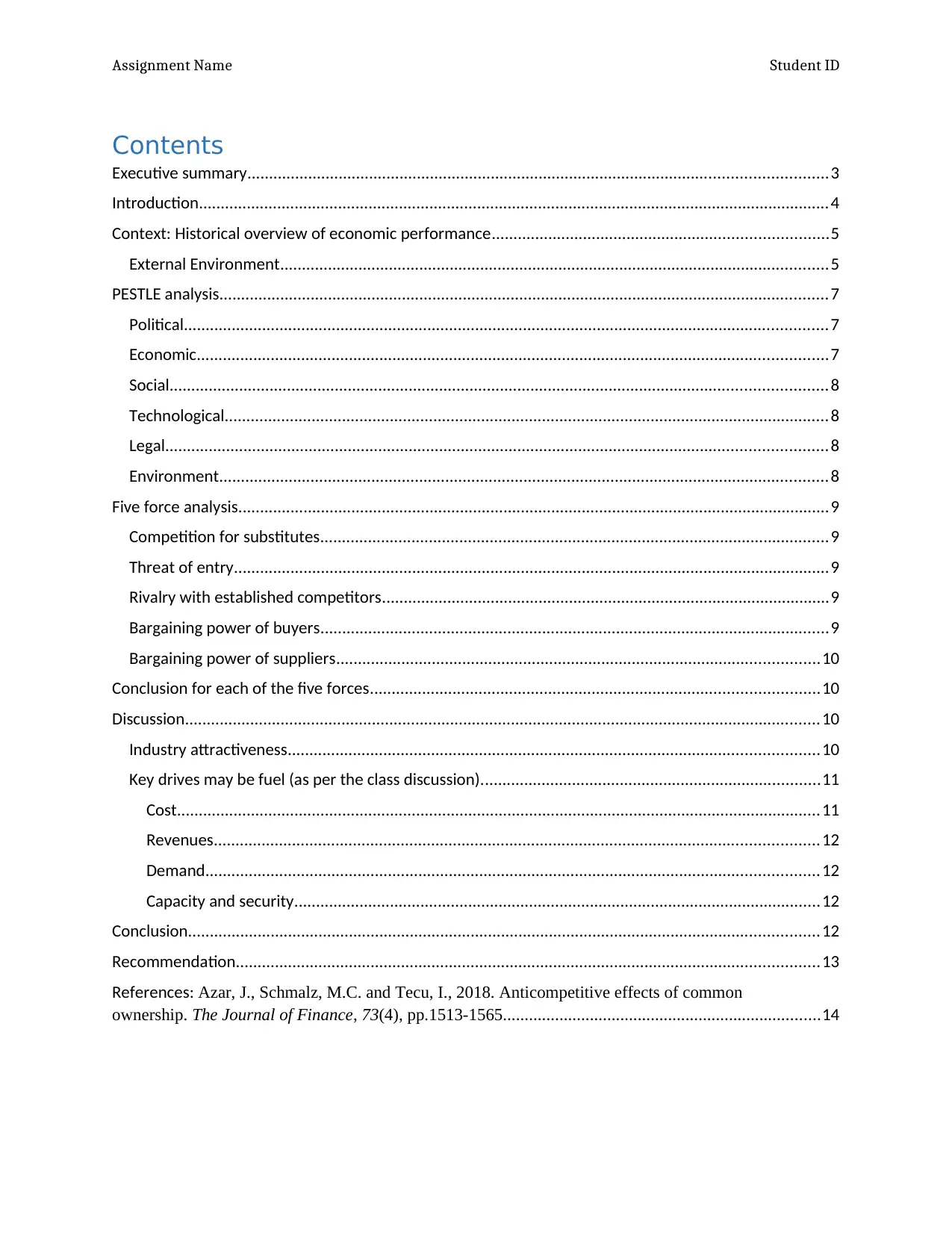
Assignment Name Student ID
Contents
Executive summary.....................................................................................................................................3
Introduction.................................................................................................................................................4
Context: Historical overview of economic performance.............................................................................5
External Environment..............................................................................................................................5
PESTLE analysis............................................................................................................................................7
Political....................................................................................................................................................7
Economic.................................................................................................................................................7
Social.......................................................................................................................................................8
Technological...........................................................................................................................................8
Legal........................................................................................................................................................8
Environment............................................................................................................................................8
Five force analysis........................................................................................................................................9
Competition for substitutes.....................................................................................................................9
Threat of entry.........................................................................................................................................9
Rivalry with established competitors.......................................................................................................9
Bargaining power of buyers.....................................................................................................................9
Bargaining power of suppliers...............................................................................................................10
Conclusion for each of the five forces.......................................................................................................10
Discussion..................................................................................................................................................10
Industry attractiveness..........................................................................................................................10
Key drives may be fuel (as per the class discussion)..............................................................................11
Cost....................................................................................................................................................11
Revenues...........................................................................................................................................12
Demand.............................................................................................................................................12
Capacity and security.........................................................................................................................12
Conclusion.................................................................................................................................................12
Recommendation......................................................................................................................................13
References: Azar, J., Schmalz, M.C. and Tecu, I., 2018. Anticompetitive effects of common
ownership. The Journal of Finance, 73(4), pp.1513-1565.........................................................................14
Contents
Executive summary.....................................................................................................................................3
Introduction.................................................................................................................................................4
Context: Historical overview of economic performance.............................................................................5
External Environment..............................................................................................................................5
PESTLE analysis............................................................................................................................................7
Political....................................................................................................................................................7
Economic.................................................................................................................................................7
Social.......................................................................................................................................................8
Technological...........................................................................................................................................8
Legal........................................................................................................................................................8
Environment............................................................................................................................................8
Five force analysis........................................................................................................................................9
Competition for substitutes.....................................................................................................................9
Threat of entry.........................................................................................................................................9
Rivalry with established competitors.......................................................................................................9
Bargaining power of buyers.....................................................................................................................9
Bargaining power of suppliers...............................................................................................................10
Conclusion for each of the five forces.......................................................................................................10
Discussion..................................................................................................................................................10
Industry attractiveness..........................................................................................................................10
Key drives may be fuel (as per the class discussion)..............................................................................11
Cost....................................................................................................................................................11
Revenues...........................................................................................................................................12
Demand.............................................................................................................................................12
Capacity and security.........................................................................................................................12
Conclusion.................................................................................................................................................12
Recommendation......................................................................................................................................13
References: Azar, J., Schmalz, M.C. and Tecu, I., 2018. Anticompetitive effects of common
ownership. The Journal of Finance, 73(4), pp.1513-1565.........................................................................14
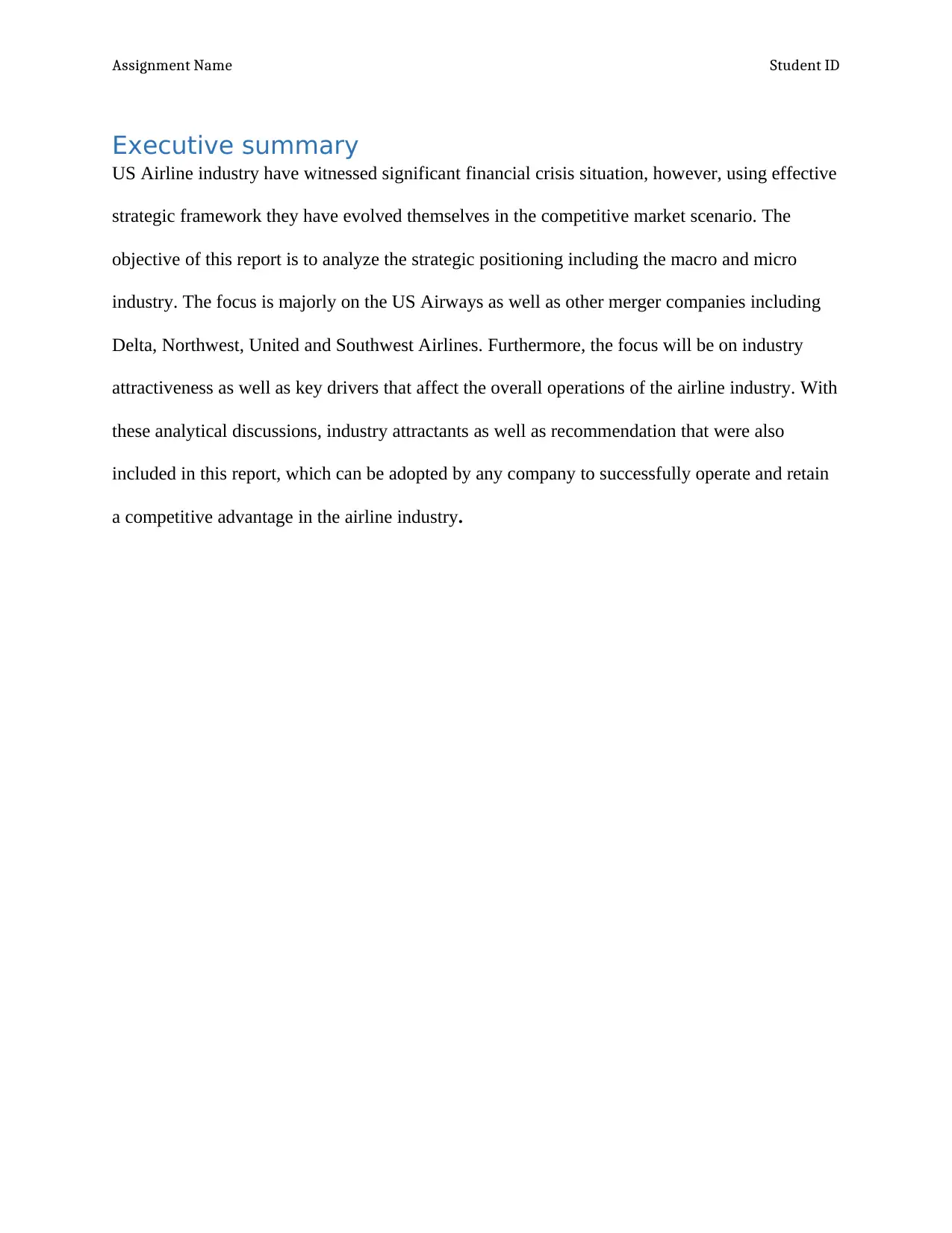
Assignment Name Student ID
Executive summary
US Airline industry have witnessed significant financial crisis situation, however, using effective
strategic framework they have evolved themselves in the competitive market scenario. The
objective of this report is to analyze the strategic positioning including the macro and micro
industry. The focus is majorly on the US Airways as well as other merger companies including
Delta, Northwest, United and Southwest Airlines. Furthermore, the focus will be on industry
attractiveness as well as key drivers that affect the overall operations of the airline industry. With
these analytical discussions, industry attractants as well as recommendation that were also
included in this report, which can be adopted by any company to successfully operate and retain
a competitive advantage in the airline industry.
Executive summary
US Airline industry have witnessed significant financial crisis situation, however, using effective
strategic framework they have evolved themselves in the competitive market scenario. The
objective of this report is to analyze the strategic positioning including the macro and micro
industry. The focus is majorly on the US Airways as well as other merger companies including
Delta, Northwest, United and Southwest Airlines. Furthermore, the focus will be on industry
attractiveness as well as key drivers that affect the overall operations of the airline industry. With
these analytical discussions, industry attractants as well as recommendation that were also
included in this report, which can be adopted by any company to successfully operate and retain
a competitive advantage in the airline industry.
⊘ This is a preview!⊘
Do you want full access?
Subscribe today to unlock all pages.

Trusted by 1+ million students worldwide
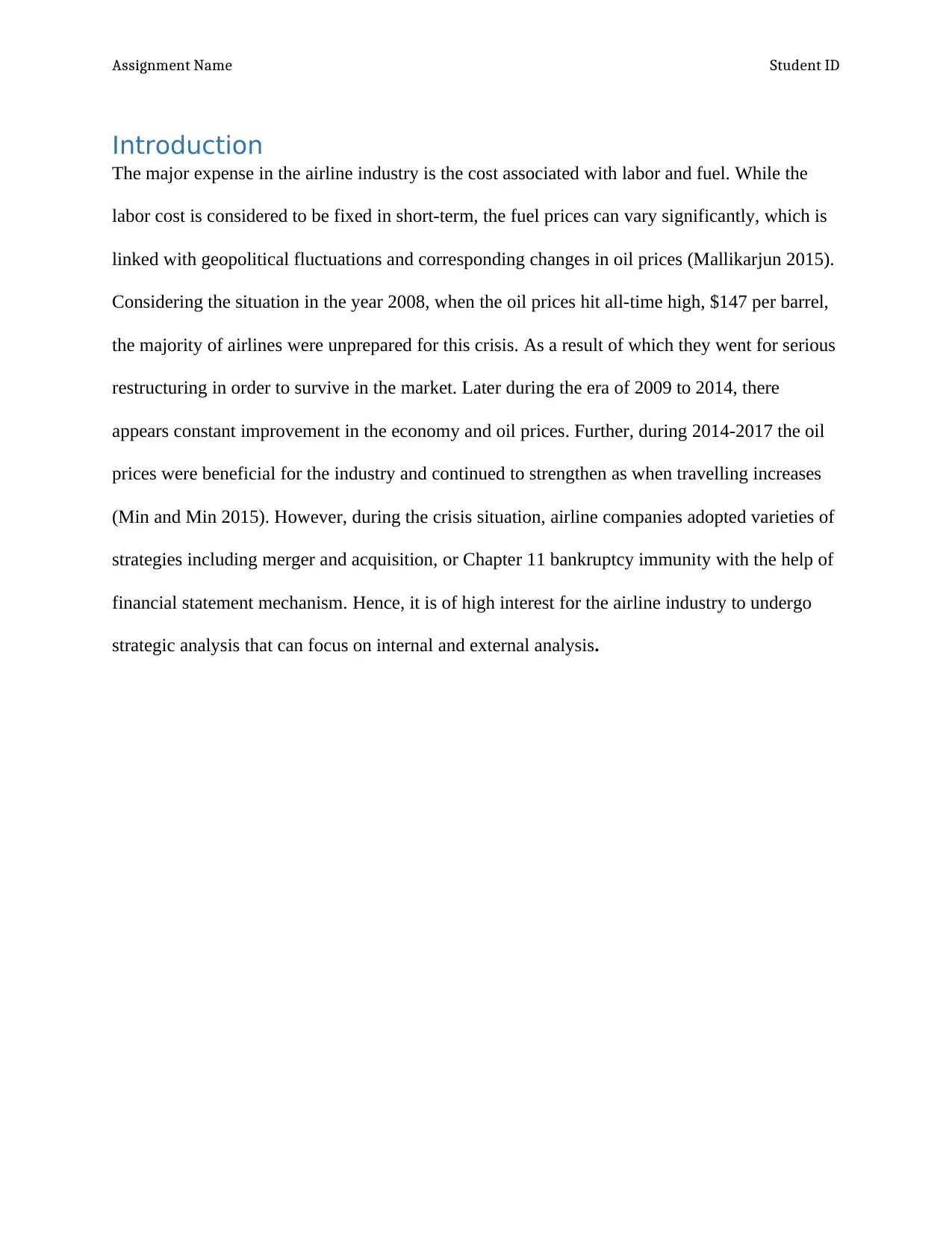
Assignment Name Student ID
Introduction
The major expense in the airline industry is the cost associated with labor and fuel. While the
labor cost is considered to be fixed in short-term, the fuel prices can vary significantly, which is
linked with geopolitical fluctuations and corresponding changes in oil prices (Mallikarjun 2015).
Considering the situation in the year 2008, when the oil prices hit all-time high, $147 per barrel,
the majority of airlines were unprepared for this crisis. As a result of which they went for serious
restructuring in order to survive in the market. Later during the era of 2009 to 2014, there
appears constant improvement in the economy and oil prices. Further, during 2014-2017 the oil
prices were beneficial for the industry and continued to strengthen as when travelling increases
(Min and Min 2015). However, during the crisis situation, airline companies adopted varieties of
strategies including merger and acquisition, or Chapter 11 bankruptcy immunity with the help of
financial statement mechanism. Hence, it is of high interest for the airline industry to undergo
strategic analysis that can focus on internal and external analysis.
Introduction
The major expense in the airline industry is the cost associated with labor and fuel. While the
labor cost is considered to be fixed in short-term, the fuel prices can vary significantly, which is
linked with geopolitical fluctuations and corresponding changes in oil prices (Mallikarjun 2015).
Considering the situation in the year 2008, when the oil prices hit all-time high, $147 per barrel,
the majority of airlines were unprepared for this crisis. As a result of which they went for serious
restructuring in order to survive in the market. Later during the era of 2009 to 2014, there
appears constant improvement in the economy and oil prices. Further, during 2014-2017 the oil
prices were beneficial for the industry and continued to strengthen as when travelling increases
(Min and Min 2015). However, during the crisis situation, airline companies adopted varieties of
strategies including merger and acquisition, or Chapter 11 bankruptcy immunity with the help of
financial statement mechanism. Hence, it is of high interest for the airline industry to undergo
strategic analysis that can focus on internal and external analysis.
Paraphrase This Document
Need a fresh take? Get an instant paraphrase of this document with our AI Paraphraser
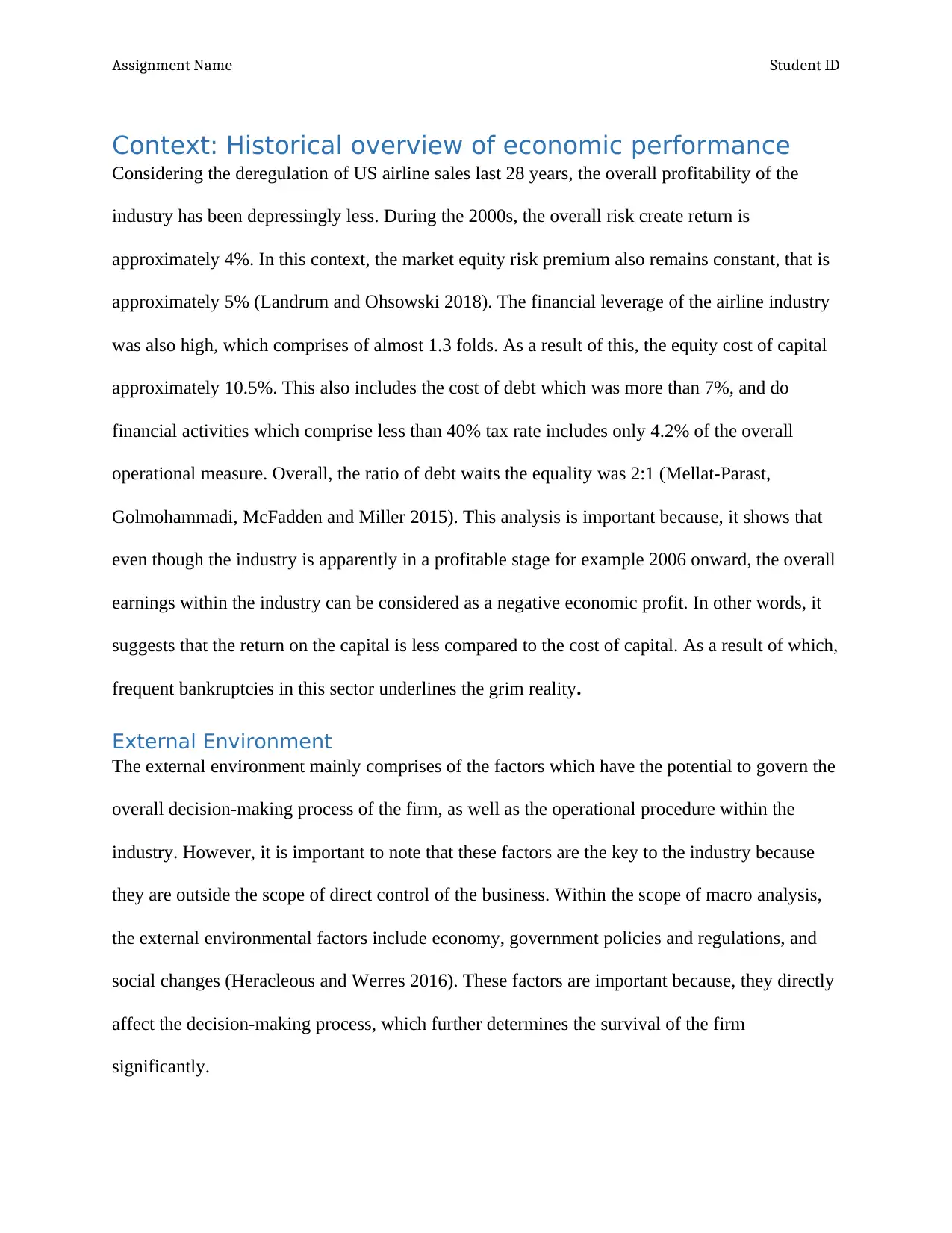
Assignment Name Student ID
Context: Historical overview of economic performance
Considering the deregulation of US airline sales last 28 years, the overall profitability of the
industry has been depressingly less. During the 2000s, the overall risk create return is
approximately 4%. In this context, the market equity risk premium also remains constant, that is
approximately 5% (Landrum and Ohsowski 2018). The financial leverage of the airline industry
was also high, which comprises of almost 1.3 folds. As a result of this, the equity cost of capital
approximately 10.5%. This also includes the cost of debt which was more than 7%, and do
financial activities which comprise less than 40% tax rate includes only 4.2% of the overall
operational measure. Overall, the ratio of debt waits the equality was 2:1 (Mellat-Parast,
Golmohammadi, McFadden and Miller 2015). This analysis is important because, it shows that
even though the industry is apparently in a profitable stage for example 2006 onward, the overall
earnings within the industry can be considered as a negative economic profit. In other words, it
suggests that the return on the capital is less compared to the cost of capital. As a result of which,
frequent bankruptcies in this sector underlines the grim reality.
External Environment
The external environment mainly comprises of the factors which have the potential to govern the
overall decision-making process of the firm, as well as the operational procedure within the
industry. However, it is important to note that these factors are the key to the industry because
they are outside the scope of direct control of the business. Within the scope of macro analysis,
the external environmental factors include economy, government policies and regulations, and
social changes (Heracleous and Werres 2016). These factors are important because, they directly
affect the decision-making process, which further determines the survival of the firm
significantly.
Context: Historical overview of economic performance
Considering the deregulation of US airline sales last 28 years, the overall profitability of the
industry has been depressingly less. During the 2000s, the overall risk create return is
approximately 4%. In this context, the market equity risk premium also remains constant, that is
approximately 5% (Landrum and Ohsowski 2018). The financial leverage of the airline industry
was also high, which comprises of almost 1.3 folds. As a result of this, the equity cost of capital
approximately 10.5%. This also includes the cost of debt which was more than 7%, and do
financial activities which comprise less than 40% tax rate includes only 4.2% of the overall
operational measure. Overall, the ratio of debt waits the equality was 2:1 (Mellat-Parast,
Golmohammadi, McFadden and Miller 2015). This analysis is important because, it shows that
even though the industry is apparently in a profitable stage for example 2006 onward, the overall
earnings within the industry can be considered as a negative economic profit. In other words, it
suggests that the return on the capital is less compared to the cost of capital. As a result of which,
frequent bankruptcies in this sector underlines the grim reality.
External Environment
The external environment mainly comprises of the factors which have the potential to govern the
overall decision-making process of the firm, as well as the operational procedure within the
industry. However, it is important to note that these factors are the key to the industry because
they are outside the scope of direct control of the business. Within the scope of macro analysis,
the external environmental factors include economy, government policies and regulations, and
social changes (Heracleous and Werres 2016). These factors are important because, they directly
affect the decision-making process, which further determines the survival of the firm
significantly.
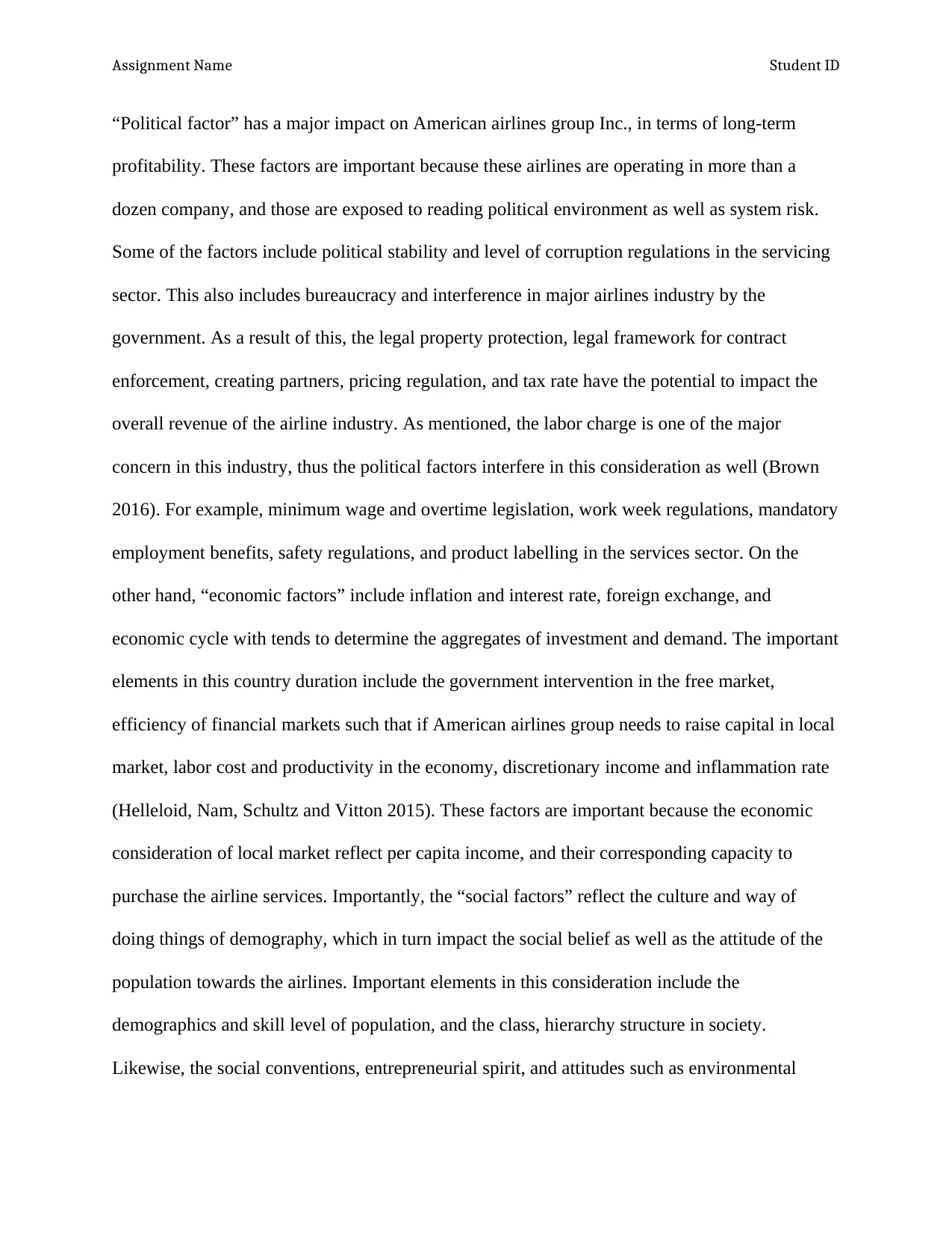
Assignment Name Student ID
“Political factor” has a major impact on American airlines group Inc., in terms of long-term
profitability. These factors are important because these airlines are operating in more than a
dozen company, and those are exposed to reading political environment as well as system risk.
Some of the factors include political stability and level of corruption regulations in the servicing
sector. This also includes bureaucracy and interference in major airlines industry by the
government. As a result of this, the legal property protection, legal framework for contract
enforcement, creating partners, pricing regulation, and tax rate have the potential to impact the
overall revenue of the airline industry. As mentioned, the labor charge is one of the major
concern in this industry, thus the political factors interfere in this consideration as well (Brown
2016). For example, minimum wage and overtime legislation, work week regulations, mandatory
employment benefits, safety regulations, and product labelling in the services sector. On the
other hand, “economic factors” include inflation and interest rate, foreign exchange, and
economic cycle with tends to determine the aggregates of investment and demand. The important
elements in this country duration include the government intervention in the free market,
efficiency of financial markets such that if American airlines group needs to raise capital in local
market, labor cost and productivity in the economy, discretionary income and inflammation rate
(Helleloid, Nam, Schultz and Vitton 2015). These factors are important because the economic
consideration of local market reflect per capita income, and their corresponding capacity to
purchase the airline services. Importantly, the “social factors” reflect the culture and way of
doing things of demography, which in turn impact the social belief as well as the attitude of the
population towards the airlines. Important elements in this consideration include the
demographics and skill level of population, and the class, hierarchy structure in society.
Likewise, the social conventions, entrepreneurial spirit, and attitudes such as environmental
“Political factor” has a major impact on American airlines group Inc., in terms of long-term
profitability. These factors are important because these airlines are operating in more than a
dozen company, and those are exposed to reading political environment as well as system risk.
Some of the factors include political stability and level of corruption regulations in the servicing
sector. This also includes bureaucracy and interference in major airlines industry by the
government. As a result of this, the legal property protection, legal framework for contract
enforcement, creating partners, pricing regulation, and tax rate have the potential to impact the
overall revenue of the airline industry. As mentioned, the labor charge is one of the major
concern in this industry, thus the political factors interfere in this consideration as well (Brown
2016). For example, minimum wage and overtime legislation, work week regulations, mandatory
employment benefits, safety regulations, and product labelling in the services sector. On the
other hand, “economic factors” include inflation and interest rate, foreign exchange, and
economic cycle with tends to determine the aggregates of investment and demand. The important
elements in this country duration include the government intervention in the free market,
efficiency of financial markets such that if American airlines group needs to raise capital in local
market, labor cost and productivity in the economy, discretionary income and inflammation rate
(Helleloid, Nam, Schultz and Vitton 2015). These factors are important because the economic
consideration of local market reflect per capita income, and their corresponding capacity to
purchase the airline services. Importantly, the “social factors” reflect the culture and way of
doing things of demography, which in turn impact the social belief as well as the attitude of the
population towards the airlines. Important elements in this consideration include the
demographics and skill level of population, and the class, hierarchy structure in society.
Likewise, the social conventions, entrepreneurial spirit, and attitudes such as environmental
⊘ This is a preview!⊘
Do you want full access?
Subscribe today to unlock all pages.

Trusted by 1+ million students worldwide
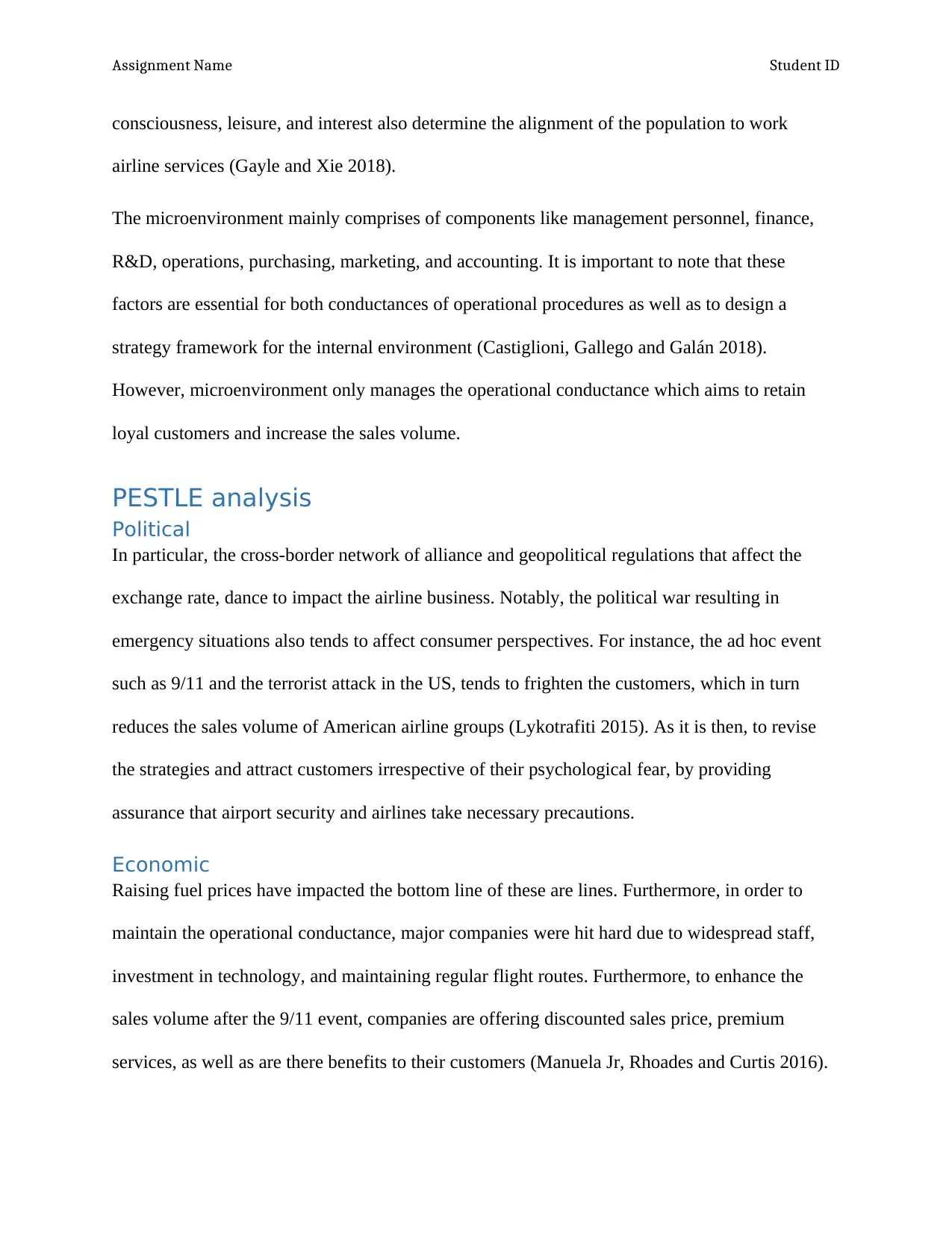
Assignment Name Student ID
consciousness, leisure, and interest also determine the alignment of the population to work
airline services (Gayle and Xie 2018).
The microenvironment mainly comprises of components like management personnel, finance,
R&D, operations, purchasing, marketing, and accounting. It is important to note that these
factors are essential for both conductances of operational procedures as well as to design a
strategy framework for the internal environment (Castiglioni, Gallego and Galán 2018).
However, microenvironment only manages the operational conductance which aims to retain
loyal customers and increase the sales volume.
PESTLE analysis
Political
In particular, the cross-border network of alliance and geopolitical regulations that affect the
exchange rate, dance to impact the airline business. Notably, the political war resulting in
emergency situations also tends to affect consumer perspectives. For instance, the ad hoc event
such as 9/11 and the terrorist attack in the US, tends to frighten the customers, which in turn
reduces the sales volume of American airline groups (Lykotrafiti 2015). As it is then, to revise
the strategies and attract customers irrespective of their psychological fear, by providing
assurance that airport security and airlines take necessary precautions.
Economic
Raising fuel prices have impacted the bottom line of these are lines. Furthermore, in order to
maintain the operational conductance, major companies were hit hard due to widespread staff,
investment in technology, and maintaining regular flight routes. Furthermore, to enhance the
sales volume after the 9/11 event, companies are offering discounted sales price, premium
services, as well as are there benefits to their customers (Manuela Jr, Rhoades and Curtis 2016).
consciousness, leisure, and interest also determine the alignment of the population to work
airline services (Gayle and Xie 2018).
The microenvironment mainly comprises of components like management personnel, finance,
R&D, operations, purchasing, marketing, and accounting. It is important to note that these
factors are essential for both conductances of operational procedures as well as to design a
strategy framework for the internal environment (Castiglioni, Gallego and Galán 2018).
However, microenvironment only manages the operational conductance which aims to retain
loyal customers and increase the sales volume.
PESTLE analysis
Political
In particular, the cross-border network of alliance and geopolitical regulations that affect the
exchange rate, dance to impact the airline business. Notably, the political war resulting in
emergency situations also tends to affect consumer perspectives. For instance, the ad hoc event
such as 9/11 and the terrorist attack in the US, tends to frighten the customers, which in turn
reduces the sales volume of American airline groups (Lykotrafiti 2015). As it is then, to revise
the strategies and attract customers irrespective of their psychological fear, by providing
assurance that airport security and airlines take necessary precautions.
Economic
Raising fuel prices have impacted the bottom line of these are lines. Furthermore, in order to
maintain the operational conductance, major companies were hit hard due to widespread staff,
investment in technology, and maintaining regular flight routes. Furthermore, to enhance the
sales volume after the 9/11 event, companies are offering discounted sales price, premium
services, as well as are there benefits to their customers (Manuela Jr, Rhoades and Curtis 2016).
Paraphrase This Document
Need a fresh take? Get an instant paraphrase of this document with our AI Paraphraser
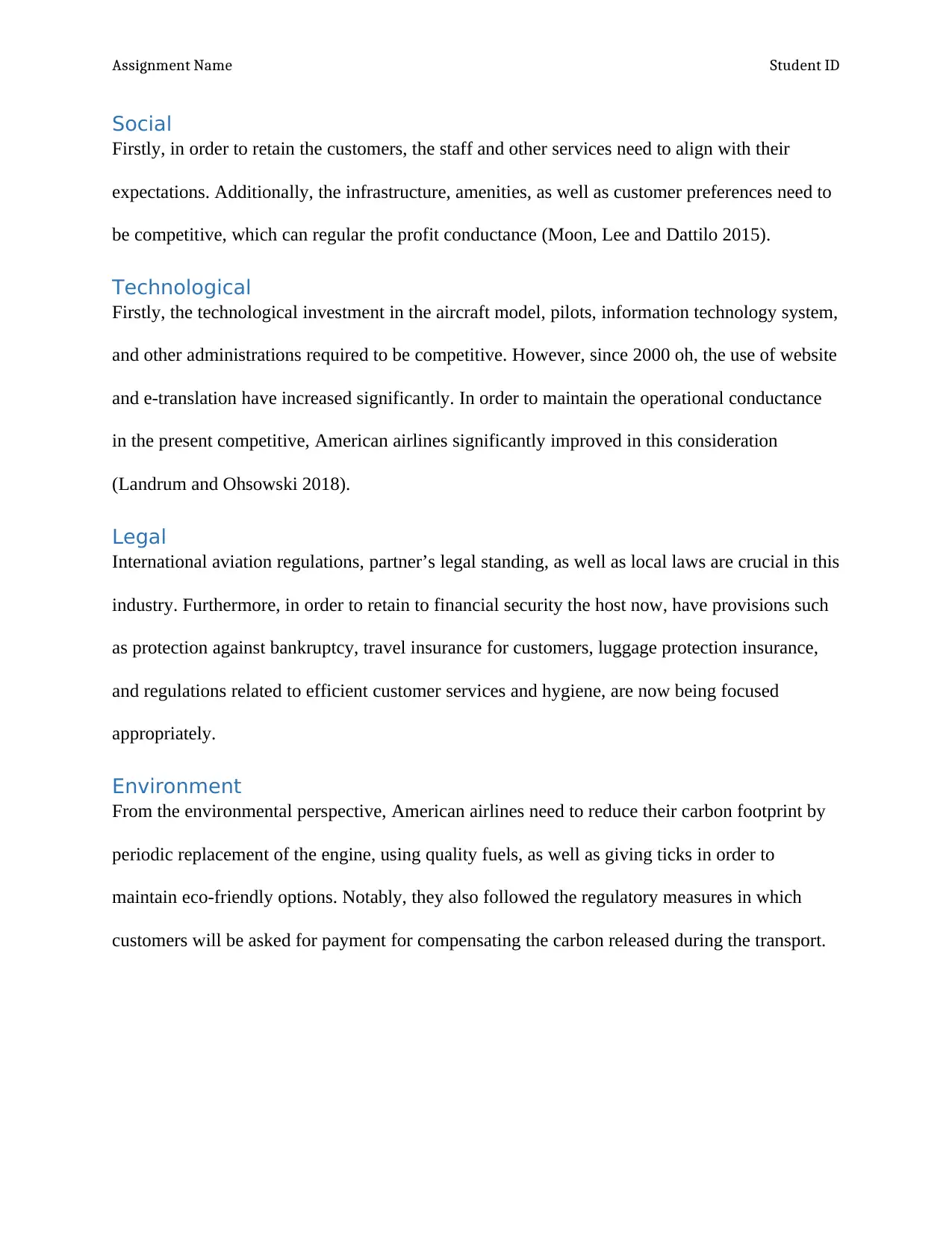
Assignment Name Student ID
Social
Firstly, in order to retain the customers, the staff and other services need to align with their
expectations. Additionally, the infrastructure, amenities, as well as customer preferences need to
be competitive, which can regular the profit conductance (Moon, Lee and Dattilo 2015).
Technological
Firstly, the technological investment in the aircraft model, pilots, information technology system,
and other administrations required to be competitive. However, since 2000 oh, the use of website
and e-translation have increased significantly. In order to maintain the operational conductance
in the present competitive, American airlines significantly improved in this consideration
(Landrum and Ohsowski 2018).
Legal
International aviation regulations, partner’s legal standing, as well as local laws are crucial in this
industry. Furthermore, in order to retain to financial security the host now, have provisions such
as protection against bankruptcy, travel insurance for customers, luggage protection insurance,
and regulations related to efficient customer services and hygiene, are now being focused
appropriately.
Environment
From the environmental perspective, American airlines need to reduce their carbon footprint by
periodic replacement of the engine, using quality fuels, as well as giving ticks in order to
maintain eco-friendly options. Notably, they also followed the regulatory measures in which
customers will be asked for payment for compensating the carbon released during the transport.
Social
Firstly, in order to retain the customers, the staff and other services need to align with their
expectations. Additionally, the infrastructure, amenities, as well as customer preferences need to
be competitive, which can regular the profit conductance (Moon, Lee and Dattilo 2015).
Technological
Firstly, the technological investment in the aircraft model, pilots, information technology system,
and other administrations required to be competitive. However, since 2000 oh, the use of website
and e-translation have increased significantly. In order to maintain the operational conductance
in the present competitive, American airlines significantly improved in this consideration
(Landrum and Ohsowski 2018).
Legal
International aviation regulations, partner’s legal standing, as well as local laws are crucial in this
industry. Furthermore, in order to retain to financial security the host now, have provisions such
as protection against bankruptcy, travel insurance for customers, luggage protection insurance,
and regulations related to efficient customer services and hygiene, are now being focused
appropriately.
Environment
From the environmental perspective, American airlines need to reduce their carbon footprint by
periodic replacement of the engine, using quality fuels, as well as giving ticks in order to
maintain eco-friendly options. Notably, they also followed the regulatory measures in which
customers will be asked for payment for compensating the carbon released during the transport.
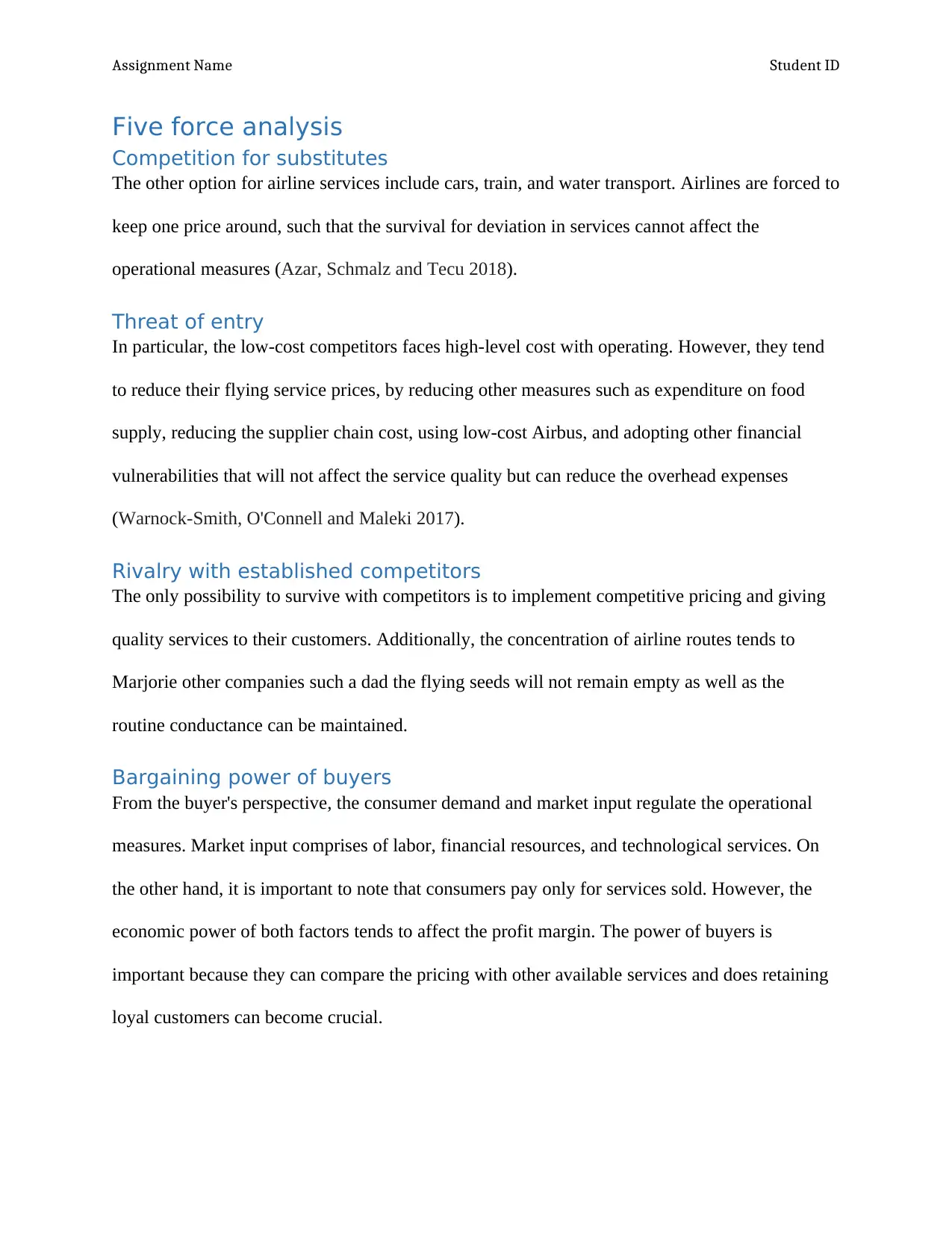
Assignment Name Student ID
Five force analysis
Competition for substitutes
The other option for airline services include cars, train, and water transport. Airlines are forced to
keep one price around, such that the survival for deviation in services cannot affect the
operational measures (Azar, Schmalz and Tecu 2018).
Threat of entry
In particular, the low-cost competitors faces high-level cost with operating. However, they tend
to reduce their flying service prices, by reducing other measures such as expenditure on food
supply, reducing the supplier chain cost, using low-cost Airbus, and adopting other financial
vulnerabilities that will not affect the service quality but can reduce the overhead expenses
(Warnock-Smith, O'Connell and Maleki 2017).
Rivalry with established competitors
The only possibility to survive with competitors is to implement competitive pricing and giving
quality services to their customers. Additionally, the concentration of airline routes tends to
Marjorie other companies such a dad the flying seeds will not remain empty as well as the
routine conductance can be maintained.
Bargaining power of buyers
From the buyer's perspective, the consumer demand and market input regulate the operational
measures. Market input comprises of labor, financial resources, and technological services. On
the other hand, it is important to note that consumers pay only for services sold. However, the
economic power of both factors tends to affect the profit margin. The power of buyers is
important because they can compare the pricing with other available services and does retaining
loyal customers can become crucial.
Five force analysis
Competition for substitutes
The other option for airline services include cars, train, and water transport. Airlines are forced to
keep one price around, such that the survival for deviation in services cannot affect the
operational measures (Azar, Schmalz and Tecu 2018).
Threat of entry
In particular, the low-cost competitors faces high-level cost with operating. However, they tend
to reduce their flying service prices, by reducing other measures such as expenditure on food
supply, reducing the supplier chain cost, using low-cost Airbus, and adopting other financial
vulnerabilities that will not affect the service quality but can reduce the overhead expenses
(Warnock-Smith, O'Connell and Maleki 2017).
Rivalry with established competitors
The only possibility to survive with competitors is to implement competitive pricing and giving
quality services to their customers. Additionally, the concentration of airline routes tends to
Marjorie other companies such a dad the flying seeds will not remain empty as well as the
routine conductance can be maintained.
Bargaining power of buyers
From the buyer's perspective, the consumer demand and market input regulate the operational
measures. Market input comprises of labor, financial resources, and technological services. On
the other hand, it is important to note that consumers pay only for services sold. However, the
economic power of both factors tends to affect the profit margin. The power of buyers is
important because they can compare the pricing with other available services and does retaining
loyal customers can become crucial.
⊘ This is a preview!⊘
Do you want full access?
Subscribe today to unlock all pages.

Trusted by 1+ million students worldwide
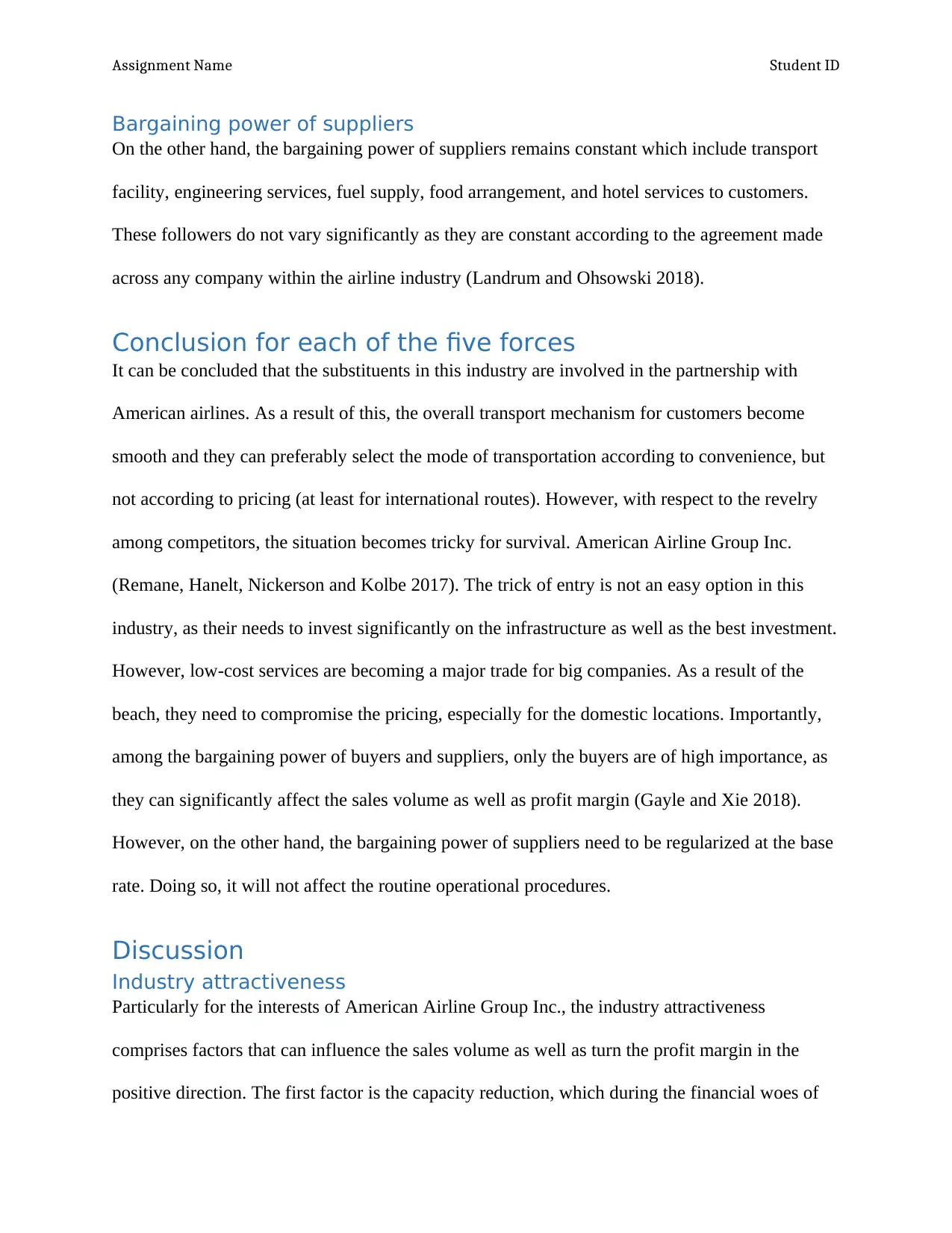
Assignment Name Student ID
Bargaining power of suppliers
On the other hand, the bargaining power of suppliers remains constant which include transport
facility, engineering services, fuel supply, food arrangement, and hotel services to customers.
These followers do not vary significantly as they are constant according to the agreement made
across any company within the airline industry (Landrum and Ohsowski 2018).
Conclusion for each of the five forces
It can be concluded that the substituents in this industry are involved in the partnership with
American airlines. As a result of this, the overall transport mechanism for customers become
smooth and they can preferably select the mode of transportation according to convenience, but
not according to pricing (at least for international routes). However, with respect to the revelry
among competitors, the situation becomes tricky for survival. American Airline Group Inc.
(Remane, Hanelt, Nickerson and Kolbe 2017). The trick of entry is not an easy option in this
industry, as their needs to invest significantly on the infrastructure as well as the best investment.
However, low-cost services are becoming a major trade for big companies. As a result of the
beach, they need to compromise the pricing, especially for the domestic locations. Importantly,
among the bargaining power of buyers and suppliers, only the buyers are of high importance, as
they can significantly affect the sales volume as well as profit margin (Gayle and Xie 2018).
However, on the other hand, the bargaining power of suppliers need to be regularized at the base
rate. Doing so, it will not affect the routine operational procedures.
Discussion
Industry attractiveness
Particularly for the interests of American Airline Group Inc., the industry attractiveness
comprises factors that can influence the sales volume as well as turn the profit margin in the
positive direction. The first factor is the capacity reduction, which during the financial woes of
Bargaining power of suppliers
On the other hand, the bargaining power of suppliers remains constant which include transport
facility, engineering services, fuel supply, food arrangement, and hotel services to customers.
These followers do not vary significantly as they are constant according to the agreement made
across any company within the airline industry (Landrum and Ohsowski 2018).
Conclusion for each of the five forces
It can be concluded that the substituents in this industry are involved in the partnership with
American airlines. As a result of this, the overall transport mechanism for customers become
smooth and they can preferably select the mode of transportation according to convenience, but
not according to pricing (at least for international routes). However, with respect to the revelry
among competitors, the situation becomes tricky for survival. American Airline Group Inc.
(Remane, Hanelt, Nickerson and Kolbe 2017). The trick of entry is not an easy option in this
industry, as their needs to invest significantly on the infrastructure as well as the best investment.
However, low-cost services are becoming a major trade for big companies. As a result of the
beach, they need to compromise the pricing, especially for the domestic locations. Importantly,
among the bargaining power of buyers and suppliers, only the buyers are of high importance, as
they can significantly affect the sales volume as well as profit margin (Gayle and Xie 2018).
However, on the other hand, the bargaining power of suppliers need to be regularized at the base
rate. Doing so, it will not affect the routine operational procedures.
Discussion
Industry attractiveness
Particularly for the interests of American Airline Group Inc., the industry attractiveness
comprises factors that can influence the sales volume as well as turn the profit margin in the
positive direction. The first factor is the capacity reduction, which during the financial woes of
Paraphrase This Document
Need a fresh take? Get an instant paraphrase of this document with our AI Paraphraser
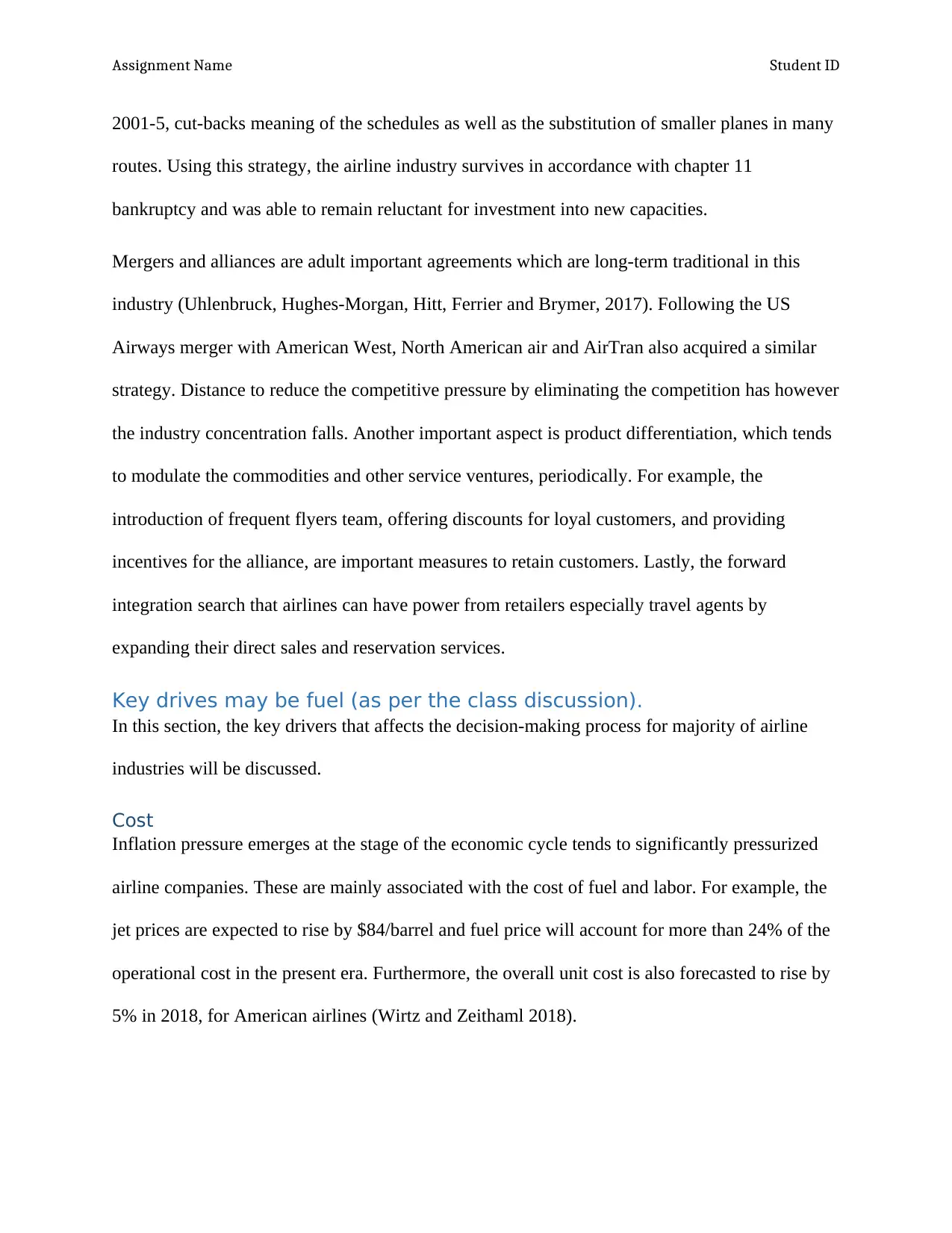
Assignment Name Student ID
2001-5, cut-backs meaning of the schedules as well as the substitution of smaller planes in many
routes. Using this strategy, the airline industry survives in accordance with chapter 11
bankruptcy and was able to remain reluctant for investment into new capacities.
Mergers and alliances are adult important agreements which are long-term traditional in this
industry (Uhlenbruck, Hughes-Morgan, Hitt, Ferrier and Brymer, 2017). Following the US
Airways merger with American West, North American air and AirTran also acquired a similar
strategy. Distance to reduce the competitive pressure by eliminating the competition has however
the industry concentration falls. Another important aspect is product differentiation, which tends
to modulate the commodities and other service ventures, periodically. For example, the
introduction of frequent flyers team, offering discounts for loyal customers, and providing
incentives for the alliance, are important measures to retain customers. Lastly, the forward
integration search that airlines can have power from retailers especially travel agents by
expanding their direct sales and reservation services.
Key drives may be fuel (as per the class discussion).
In this section, the key drivers that affects the decision-making process for majority of airline
industries will be discussed.
Cost
Inflation pressure emerges at the stage of the economic cycle tends to significantly pressurized
airline companies. These are mainly associated with the cost of fuel and labor. For example, the
jet prices are expected to rise by $84/barrel and fuel price will account for more than 24% of the
operational cost in the present era. Furthermore, the overall unit cost is also forecasted to rise by
5% in 2018, for American airlines (Wirtz and Zeithaml 2018).
2001-5, cut-backs meaning of the schedules as well as the substitution of smaller planes in many
routes. Using this strategy, the airline industry survives in accordance with chapter 11
bankruptcy and was able to remain reluctant for investment into new capacities.
Mergers and alliances are adult important agreements which are long-term traditional in this
industry (Uhlenbruck, Hughes-Morgan, Hitt, Ferrier and Brymer, 2017). Following the US
Airways merger with American West, North American air and AirTran also acquired a similar
strategy. Distance to reduce the competitive pressure by eliminating the competition has however
the industry concentration falls. Another important aspect is product differentiation, which tends
to modulate the commodities and other service ventures, periodically. For example, the
introduction of frequent flyers team, offering discounts for loyal customers, and providing
incentives for the alliance, are important measures to retain customers. Lastly, the forward
integration search that airlines can have power from retailers especially travel agents by
expanding their direct sales and reservation services.
Key drives may be fuel (as per the class discussion).
In this section, the key drivers that affects the decision-making process for majority of airline
industries will be discussed.
Cost
Inflation pressure emerges at the stage of the economic cycle tends to significantly pressurized
airline companies. These are mainly associated with the cost of fuel and labor. For example, the
jet prices are expected to rise by $84/barrel and fuel price will account for more than 24% of the
operational cost in the present era. Furthermore, the overall unit cost is also forecasted to rise by
5% in 2018, for American airlines (Wirtz and Zeithaml 2018).
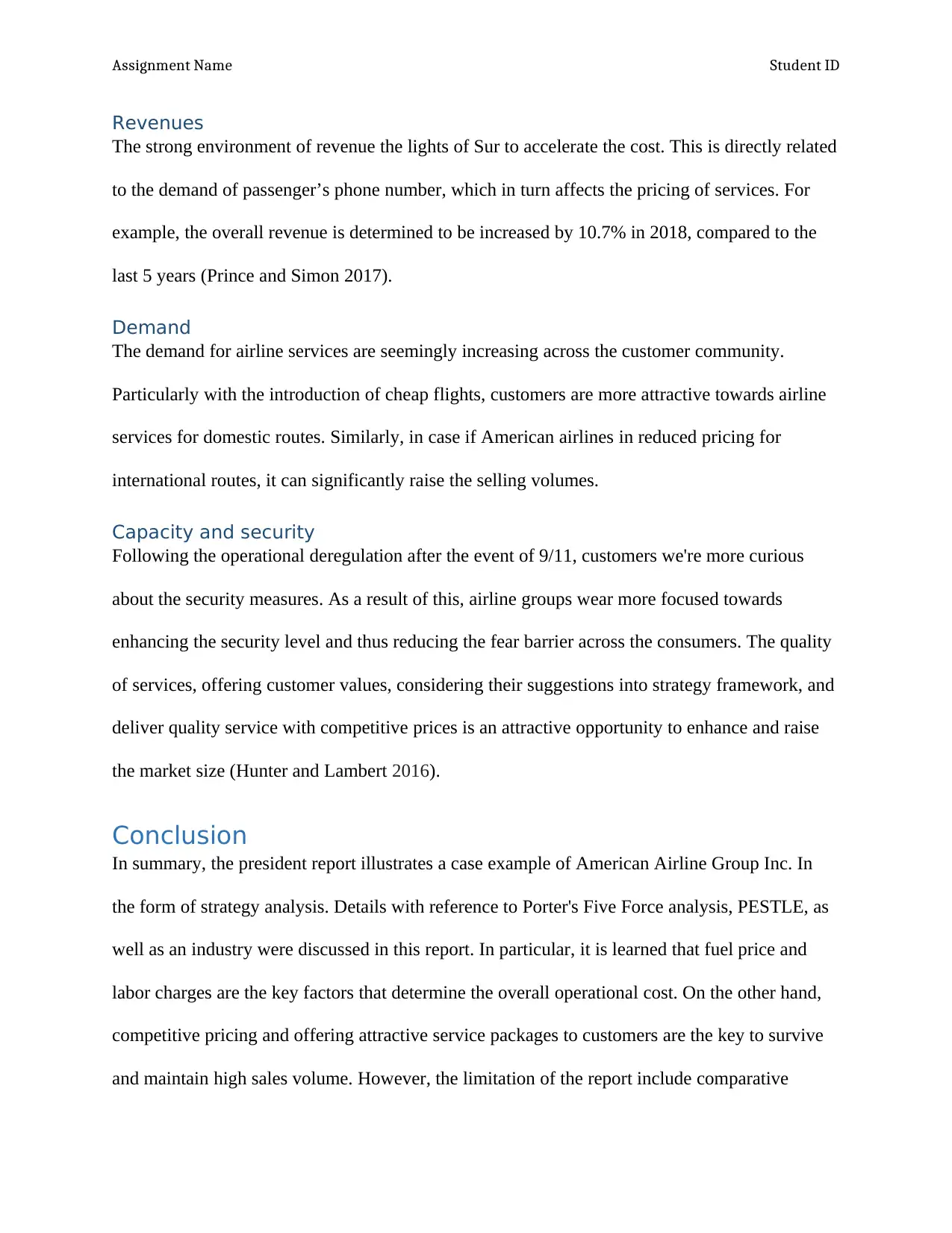
Assignment Name Student ID
Revenues
The strong environment of revenue the lights of Sur to accelerate the cost. This is directly related
to the demand of passenger’s phone number, which in turn affects the pricing of services. For
example, the overall revenue is determined to be increased by 10.7% in 2018, compared to the
last 5 years (Prince and Simon 2017).
Demand
The demand for airline services are seemingly increasing across the customer community.
Particularly with the introduction of cheap flights, customers are more attractive towards airline
services for domestic routes. Similarly, in case if American airlines in reduced pricing for
international routes, it can significantly raise the selling volumes.
Capacity and security
Following the operational deregulation after the event of 9/11, customers we're more curious
about the security measures. As a result of this, airline groups wear more focused towards
enhancing the security level and thus reducing the fear barrier across the consumers. The quality
of services, offering customer values, considering their suggestions into strategy framework, and
deliver quality service with competitive prices is an attractive opportunity to enhance and raise
the market size (Hunter and Lambert 2016).
Conclusion
In summary, the president report illustrates a case example of American Airline Group Inc. In
the form of strategy analysis. Details with reference to Porter's Five Force analysis, PESTLE, as
well as an industry were discussed in this report. In particular, it is learned that fuel price and
labor charges are the key factors that determine the overall operational cost. On the other hand,
competitive pricing and offering attractive service packages to customers are the key to survive
and maintain high sales volume. However, the limitation of the report include comparative
Revenues
The strong environment of revenue the lights of Sur to accelerate the cost. This is directly related
to the demand of passenger’s phone number, which in turn affects the pricing of services. For
example, the overall revenue is determined to be increased by 10.7% in 2018, compared to the
last 5 years (Prince and Simon 2017).
Demand
The demand for airline services are seemingly increasing across the customer community.
Particularly with the introduction of cheap flights, customers are more attractive towards airline
services for domestic routes. Similarly, in case if American airlines in reduced pricing for
international routes, it can significantly raise the selling volumes.
Capacity and security
Following the operational deregulation after the event of 9/11, customers we're more curious
about the security measures. As a result of this, airline groups wear more focused towards
enhancing the security level and thus reducing the fear barrier across the consumers. The quality
of services, offering customer values, considering their suggestions into strategy framework, and
deliver quality service with competitive prices is an attractive opportunity to enhance and raise
the market size (Hunter and Lambert 2016).
Conclusion
In summary, the president report illustrates a case example of American Airline Group Inc. In
the form of strategy analysis. Details with reference to Porter's Five Force analysis, PESTLE, as
well as an industry were discussed in this report. In particular, it is learned that fuel price and
labor charges are the key factors that determine the overall operational cost. On the other hand,
competitive pricing and offering attractive service packages to customers are the key to survive
and maintain high sales volume. However, the limitation of the report include comparative
⊘ This is a preview!⊘
Do you want full access?
Subscribe today to unlock all pages.

Trusted by 1+ million students worldwide
1 out of 16
Related Documents
Your All-in-One AI-Powered Toolkit for Academic Success.
+13062052269
info@desklib.com
Available 24*7 on WhatsApp / Email
![[object Object]](/_next/static/media/star-bottom.7253800d.svg)
Unlock your academic potential
Copyright © 2020–2025 A2Z Services. All Rights Reserved. Developed and managed by ZUCOL.





